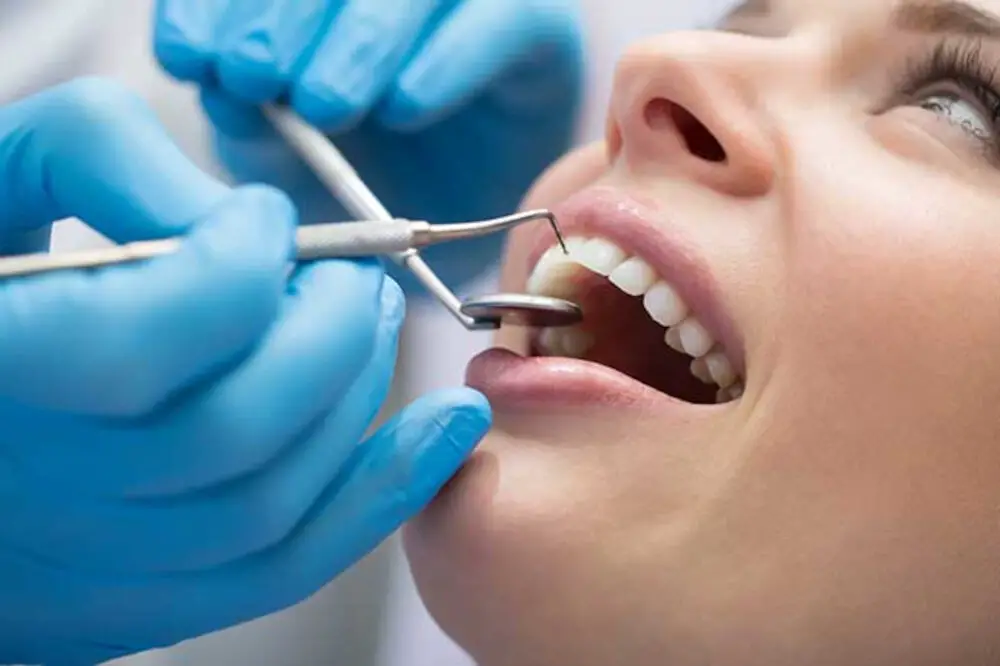Expert Advice: How Long to Keep Gauze in After Wisdom Teeth Extraction?

Oral surgery can be a daunting experience, especially when it comes to wisdom teeth extraction. After the procedure, it’s essential to take care of the wound to ensure proper healing. One of the most common questions people have is how long they should keep the gauze in after wisdom teeth extraction. While it may seem like a simple question, the answer can vary depending on the individual’s condition and the type of extraction performed. In this article, we will provide expert advice on how long to keep gauze in after wisdom teeth extraction and offer tips to promote a speedy recovery. Wisdom teeth are the last molars to emerge in the back of the mouth and can cause a host of problems, including pain, infection, and tooth decay. Removal of these teeth is a common oral surgery procedure that requires local anesthesia or sedation. After the extraction, the dentist or oral surgeon will place a gauze pad over the wound to control bleeding and promote clotting. It’s crucial to leave the gauze in place for the recommended amount of time to avoid disrupting the clotting process, which can lead to dry socket, a painful condition that occurs when the blood clot is dislodged. With our expert advice, you can ensure a smooth and comfortable healing process after your wisdom teeth extraction.
After wisdom teeth extraction, gauze is used to control bleeding and promote the formation of a blood clot. The gauze is placed over the extraction site and pressure is applied to help the clot form. This clot is essential for the healing process as it protects the underlying bone and tissue from infection and aids in the formation of new tissue. The gauze also helps to absorb any excess blood and saliva, preventing the patient from swallowing or spitting it out, which can disrupt the clot formation. It is important to follow the dentist’s instructions regarding how long to keep the gauze in place to ensure proper healing and prevent complications.
It is crucial to follow the dentist’s instructions after wisdom teeth extraction to ensure proper healing and prevent complications. The dentist’s instructions may include how long to keep gauze in after the procedure, how to manage pain and swelling, and what foods to avoid. Failure to follow these instructions can lead to prolonged bleeding, infection, and delayed healing. It is essential to understand that every individual’s healing process may differ, and following the dentist’s advice can help expedite the recovery process. Therefore, it is advisable to adhere to the dentist’s instructions to ensure a smooth and speedy recovery.
How long should you keep gauze in after wisdom teeth extraction?

After undergoing wisdom teeth extraction, your dentist will likely instruct you to bite down on a piece of gauze to help control bleeding and encourage clot formation. It’s important to follow their advice and keep the gauze in place for the recommended amount of time. Generally, you should keep the gauze in for 30-45 minutes after the procedure, or until the bleeding has stopped. It’s important not to change the gauze too frequently or too soon, as doing so can disrupt the formation of a clot and prolong bleeding. Additionally, it’s important to follow your dentist’s instructions on how frequently to change the gauze throughout the day. You may need to change it every hour or so initially, then gradually decrease the frequency as the bleeding subsides. It’s also important to avoid touching or disturbing the clot with your tongue or fingers, as this can also disrupt the healing process. Overall, following your dentist’s instructions and keeping the gauze in place for the recommended amount of time can help ensure a smooth and successful recovery after wisdom teeth extraction.
Wisdom teeth extraction is a common dental procedure that involves removing the third molars located at the back of the mouth. After the surgery, it is typical for the dentist or oral surgeon to place a piece of gauze on the extraction site to control bleeding and promote healing. The duration of gauze usage after wisdom teeth extraction varies depending on the individual’s healing process and the extent of the surgery. However, in most cases, patients are advised to keep the gauze in place for about 30-45 minutes. After that, they can remove the gauze and replace it with a new one if bleeding continues. It is crucial to follow the dentist’s instructions regarding gauze usage after wisdom teeth extraction to avoid complications and promote faster recovery.
The duration of gauze usage after wisdom teeth extraction can vary significantly based on individual factors. The amount of bleeding and the rate of healing can differ from person to person, affecting how long gauze is needed. Additionally, the complexity of the extraction procedure, the number of teeth removed, and the patient’s overall health can all impact the duration of gauze usage. Some patients may only need to use gauze for a few hours, while others may require it for several days. It is crucial to follow the guidance of the dentist or oral surgeon and to monitor the bleeding to determine when it is safe to discontinue gauze usage.
Extraction is the process of removing a tooth from its socket in the jawbone. There are several types of extraction, including simple extraction and surgical extraction. Simple extraction is performed when the tooth is visible and easily accessible. The dentist will loosen the tooth with a tool called an elevator and then use forceps to remove it from the socket. Surgical extraction is required when the tooth is impacted or has not erupted from the gum line. This type of extraction involves making an incision in the gum tissue and removing the tooth from the jawbone. The healing process after extraction can vary depending on the type of extraction performed and the individual’s overall health. It is important to follow post-operative instructions provided by the dentist to ensure proper healing and to minimize the risk of complications.
After a wisdom tooth extraction, it’s not uncommon to experience some bleeding or swelling. This is the body’s natural response to the trauma of the surgery, as the tissue around the tooth is damaged during the extraction process. Bleeding and swelling can be managed with the use of gauze, which should be placed over the extraction site and changed regularly. It’s important to monitor the amount of bleeding and swelling, as excessive amounts can be a sign of complications. If bleeding persists for more than a few hours or if there is significant swelling, it’s important to contact a dental professional for further evaluation and treatment.
Aside from wisdom teeth extraction, there are a variety of other medical conditions that may require the use of gauze. Gauze is often used to control bleeding after surgeries or other dental procedures, as well as to dress wounds and promote healing. In addition, gauze can be used to apply medication or ointment to a specific area of the body. Some medical conditions that may require the use of gauze include skin ulcers, bedsores, burns, and surgical incisions. It is important to follow the advice of your healthcare provider regarding the frequency and duration of gauze usage, as well as any other necessary steps for proper wound care.
How to properly use gauze after wisdom teeth extraction

Proper use of gauze after wisdom teeth extraction is essential to reduce bleeding, prevent infection, and promote healing. It’s recommended to keep a piece of gauze in the mouth for at least 30 minutes after the procedure. Bite down gently but firmly on the gauze to apply pressure to the extraction site, which helps to form a clot and stop bleeding. Replace the gauze with a new one every 30-45 minutes or as needed until the bleeding stops. It’s normal to have some oozing for the first 24-48 hours after the procedure, but if the bleeding persists, contact your dentist or oral surgeon immediately. After removing the gauze, rinse your mouth gently with warm saltwater to clean the area and promote healing. Do not use mouthwash or brush your teeth for the first 24 hours after the procedure. Avoid smoking, spitting, or using a straw as the suction can dislodge the clot and cause bleeding. Stick to soft foods for the first few days and avoid hot, spicy, or crunchy foods that can irritate the extraction site. Proper use of gauze, combined with good oral hygiene and following your dentist’s post-operative instructions, can ensure a smooth and speedy recovery after wisdom teeth extraction.
After a tooth extraction, it is essential to place gauze in the mouth to control bleeding. The correct technique for placing gauze in the mouth after extraction involves folding the gauze to a size that can comfortably fit in the area where the tooth was removed. It is crucial to bite down firmly on the gauze for about 45-60 minutes, applying constant pressure to the extraction site. Changing the gauze every 30 minutes until the bleeding stops is essential. It is also crucial to avoid spitting, rinsing, or touching the extraction site as this can dislodge the blood clot and delay the healing process. Following the correct technique for placing gauze in the mouth after extraction can prevent complications such as excessive bleeding and dry socket.
When changing gauze after wisdom teeth extraction, it is important to follow a few tips to promote healing and prevent complications. First, make sure to wash your hands thoroughly before handling the gauze. Gently remove the old gauze to avoid disturbing the blood clot that is forming. Place a clean piece of gauze over the extraction site and bite down firmly for 30-45 minutes. Avoid spitting, rinsing, or drinking through a straw for at least 24 hours after the procedure. If bleeding persists, contact your dentist or oral surgeon for further instructions. Changing gauze as needed is an essential part of the healing process after wisdom teeth extraction.
If gauze becomes stuck or uncomfortable after wisdom teeth extraction, it is important to remain calm and carefully remove it. To do so, moisten the gauze with water or saline solution to soften it. Then, gently remove it using a slow and steady pulling motion. If the gauze is still difficult to remove or causes excessive bleeding or pain, seek immediate professional medical attention. Additionally, if the gauze becomes uncomfortable due to irritation or pain, try adjusting it by repositioning it in the mouth or using a smaller piece of gauze. It is essential to follow the post-operative instructions provided by the dentist or oral surgeon to ensure a smooth and successful recovery.
Important considerations for postextraction care

After undergoing a tooth extraction procedure, it is crucial to follow the postextraction care guidelines to ensure quick and smooth healing of the area. One of the most important considerations for postextraction care is to avoid vigorous rinsing or spitting for at least 24 hours after the procedure. This can disrupt the blood clot that forms in the extraction site, which is crucial for healing. Patients should also avoid drinking through a straw, smoking, or consuming hot foods and beverages, as these can also dislodge the clot and delay the healing process. Another crucial aspect of postextraction care is maintaining proper oral hygiene to prevent infection. Patients should continue brushing their teeth gently and avoid the extraction site until it has fully healed. Rinsing with salt water or a prescribed mouthwash can also help prevent infection and promote healing. Additionally, patients should avoid touching the extraction site with their fingers or tongue, as this can introduce bacteria and delay healing. By following these important considerations for postextraction care, patients can minimize discomfort and ensure a quick and successful recovery from their tooth extraction procedure.
Following postoperative instructions after wisdom teeth extraction is crucial for optimal healing. These instructions are carefully designed to help the patient manage pain, reduce swelling, and prevent infection. Ignoring or neglecting these instructions can lead to complications such as dry socket, delayed healing, and infections. It is important to pay attention to instructions such as how long to keep gauze in after wisdom teeth extraction, when to start brushing, and what foods to avoid. Patients who follow these instructions are more likely to have a smoother recovery and a better outcome. It is important to remember that every patient’s recovery is different, so it is essential to follow the specific instructions provided by the dentist or oral surgeon.
Managing pain and swelling after a tooth extraction can be a challenging task, but there are ways to alleviate the discomfort. Firstly, follow your dentist’s instructions regarding pain medication and apply cold compresses to the affected area for 20 minutes at a time, several times a day. Avoid hot food and drinks and stick to soft, cool foods like yogurt, ice cream, and mashed potatoes. Gargling with salt water can also help reduce swelling and promote healing. It’s important to rest and avoid strenuous activity for a few days after the procedure. Finally, keep up with good oral hygiene practices, like brushing and flossing gently, to prevent infection and aid in the healing process.
It is important to contact your dentist if you experience any concerns or complications after a wisdom teeth extraction. If you have excessive bleeding that does not stop after applying pressure for 45 minutes, severe pain that does not improve with pain medication, or swelling that increases after the third day, you should contact your dentist immediately. Additionally, if you develop a fever or notice pus or discharge coming from the extraction site, this could be a sign of infection and you should seek dental care as soon as possible. It is always better to err on the side of caution and contact your dentist if you have any doubts or concerns.
The duration and proper use of gauze after wisdom teeth extraction is crucial for a speedy recovery. According to experts, it is recommended to keep the gauze in place for 30-45 minutes and then replace it with a new one if necessary. It is important to avoid changing the gauze too frequently as it can disturb the blood clot formation and lead to complications such as dry socket. Additionally, it is important to apply gentle pressure to the gauze to control bleeding and avoid spitting or rinsing for the first 24 hours. Proper use of gauze can help prevent complications and promote healing after wisdom teeth extraction.
Following your dentist’s instructions after wisdom teeth extraction is crucial for a smooth recovery. It is essential to keep the gauze in your mouth for the recommended time to control bleeding and encourage blood clotting. Failure to do so can result in dry sockets, a painful condition where the clot is dislodged, exposing the underlying bone and nerves. Additionally, your dentist may prescribe pain medication, antibiotics, and recommend a soft-food diet to promote healing. Neglecting these instructions can delay your recovery and increase the risk of infection and complications. Therefore, it is crucial to follow your dentist’s guidance to ensure a quick and comfortable recovery.
Conclusion

In conclusion, it is essential to follow the advice of your dental surgeon or healthcare provider when it comes to how long to keep gauze in after wisdom teeth extraction. The recovery time can vary from person to person, so it is crucial to monitor your progress and symptoms carefully. While gauze can help control bleeding and promote healing, leaving it in for too long can cause complications. Therefore, it is best to replace gauze as instructed and follow all post-operative care instructions to ensure a smooth recovery. Remember to stay hydrated, avoid hard or crunchy foods, and maintain good oral hygiene to reduce the risk of infection. With proper care and attention, you can ensure a successful recovery from wisdom teeth extraction.







